You’ve Come a Long Way, Baby!
Over recent days, as yet another 9/11 anniversary has come and gone, I have been trying to trace back how my thinking has evolved since that murky event. Two decades is quite a big chunk of anybody’s life and one’s thinking is bound to evolve. Mine certainly did. Not just about 9/11, mind you, but making sense of that event definitely played a huge role.
Eighteen years ago, my thinking about politics and history was really quite conventional. That is surely why it took me so long to question what we were told. Well, to be clear, I did question things, in particular the so-called “War on Terror”, right from the very start. I recall conversations, tense ones even, in which I told people that the invasion of Afghanistan (and Iraq all the more so) made no sense as a response to the “attacks” of 9/11. However, I now realize that my critique was all within a conventional, approved framework. I did not question the 9/11 narrative itself. For at least six or seven years, I took the official story completely at face value. I must have known vaguely that there were these “9/11 Truthers” out there but I guess I accepted the official line that these people were just a bunch of kooks, “crazed conspiracy theorists”.
So, to my everlasting shame, for about ten years after 9/11, I did not allot even a couple of hours (which is about all it takes) to examining the Truthers’ case. I find that painful to think about but I think it is useful to reconstruct the timeline — and to do so honestly. When I finally did look at the material from Architects and Engineers for 9/11 Truth it was just absurdly obvious that they were telling the truth.
Well, like most people reading this, I did eventually get there. I finally crossed the proverbial Rubicon, but I can’t say with any certainty why that happened when it did. After all, if I could ignore 9/11 Truth for ten years, presumably I could have ignored it for twenty years or thirty years, right? But, for some reason, I didn’t. Self-observation is very difficult and error-prone. As best I can guess, I finally took the step I did, of factually studying the question, because, in the preceding decade, tensions had been building up in my mind and they reached a critical point that they had to be resolved. Most of that process probably occurred subconsciously.
My Epiphany in a Bookstore. Roger Rabbit prefigured?
In this vein, I have a distinct memory of being in a huge bookstore in downtown Vancouver. This must have been the summer of 2009. One part of the store had various bins of books being sold at deep discounts. It was largely a technical bookstore so a lot of those books were older computer books since those books, in particular, become obsolete so quickly. However, one of the bins was full of copies of the 9/11 Commission Report. I don’t recall the price it was selling at. It must have been a bargain bin price, but I didn’t buy one, though I must have been thinking about it. I recall that I picked one up and was leafing through it for a while, reading different passages, even checking the footnotes. I distinctly recall having a sudden insight: “This is all bullshit! It’s just storytelling!”
Actually, I might have even blurted that out loud. To myself. I sometimes do that. If I did, I’m pretty sure nobody was listening. I also recall conversations from around that time where I would ask people: “Doesn’t Osama Bin Laden seem much more like a villain from a James Bond movie than a real person?” In retrospect, I was already on the line of thinking that ultimately led to my first in-depth essay about such topics, where I coined the term “Roger Rabbit narrative”, and spoke of the mental world populated largely (but not exclusively) by cartoon characters. I wrote that essay in early 2016, but the idea had been forming in my mind for some time. I could see that this 9/11 Commission report was dressed up to look like a serious document, extensively footnoted, but I’m sure I knew even then, on a gut level, that any attempt to verify any of it factually would just be a wild goose chase.
Again, it is a bit disturbing to reconstruct the timeline. From that epiphany in the bookstore, it still took me over two years to investigate the claims of the 9/11 Truthers. So, by 2009, eight years after the event, a side of me knew that the 9/11 narrative was “just storytelling” but that was still just at an intuitive level. I knew… kinda, sorta… but progress was still slow, maybe because there was another side of me that didn’t want to really know. So I dawdled for another two years — more like two and half years, truth be told, before really engaging in the hard facts about steel-framed high-rise buildings and controlled demolitions, and drawing the unavoidable conclusion.
That’s not a Comic Book! It’s a Graphic Novel!
Last week, a rather whimsical purchase finally arrived in my mailbox. Yes, a copy of the 9/11 Commission Report! But not the one I had scanned through in that bookstore a decade ago. This was the Illustrated 9/11 Commission Report. It is sitting on my desk right now.
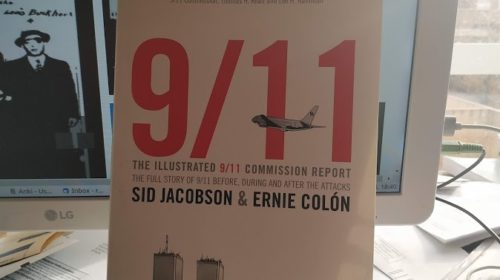
I had noticed that a third party bookseller was selling a copy on amazon.co.uk for 1 pound. (About $1.20 US.) Well, the catch was that delivery (to Spain, where I live) was the princely sum of 4 pounds. Even so, I feel I got my money’s worth. Just for starters, I never heard of any government commission report being put out in comic book (excuse me, pictorial) format, so already, on those grounds, it seemed like a novel enough artifact that it ought to be worth owning one. I figured I could leave it on a coffee table and it would be a surefire conversation starter. It also vaguely occurred to me that the book would contain some visuals that could be used as a humorous visual counterpoint in some serious articles. Things like this:
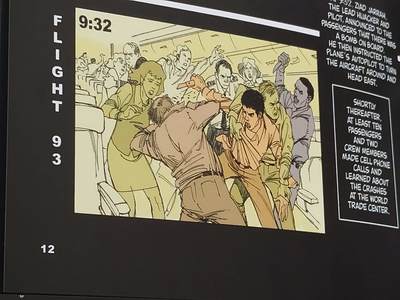
Supposedly, in the time shortly before 9/11, President Bush received a report warning him that “Bin Laden was planning to strike America”. However, he seems to have ignored it, or so they say. Perhaps the moral of the story is that the report should have been in comic book format. Heck, for all I know, with Trump as president, this is now the standard policy. With visuals like this, how could any president ignore the terrorist threat?
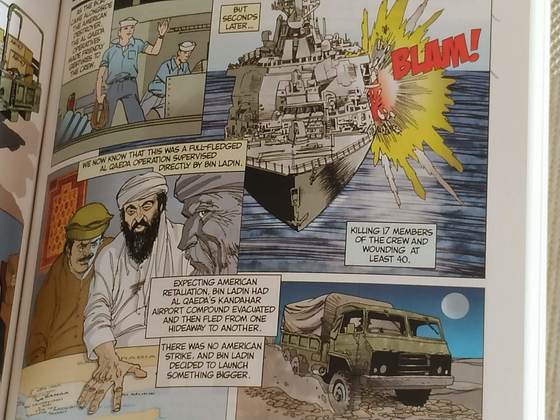
To be clear, this illustrated edition of the 9/11 Commission Report is not some rogue effort. It was done with the official backing of the 9/11 Commission and was first published not long after the regular report. There is even a foreword by the commission’s co-chairs, Kean and Hamilton. The foreword is odd because, taken at face value, it could even seem to contain some surprising admissions:
… we are pleased to have the opportunity to bring the work of the 9/11 Commission to the attention of a new set of readers. We commend the talented graphic artists of this edition… We believe that you will find the story of 9/11 a gripping one, whether in narrative or pictorial form… (My emphasis)
Yes, Kean and Hamilton refer to this as a “story”, a “narrative”. Not just a story, but a “gripping” one, no less. Granted, I assume that, if pressed, they would hasten to add that it is a true story. Still, I wonder whether people on the brink of their own “this is just storytelling” epiphany on 9/11, when faced with this comic book pictorial version of the 9/11 Commission Report might be pushed over the edge. When I was in the bookstore, thumbing through the original dense report, I already was suspecting that the whole thing was a comic book, but if the thing actually had been a comic book… literally…
It really does make my head spin. Kean and Hamilton’s foreword ends like so:
… we hope that this graphic version will encourage our fellow citizens to study, reflect, and act.
Offhand, I don’t know what Kean and Hamilton meant by “encouraging their fellow citizens to act“. What do they mean by that? Going shopping? As for studying and reflecting, well, those are good things but one should not overdo it, eh? They must have realized that the original commission report just had too many damned words. (Probably some annoyingly big-ass words too…)
We should encourage our fellow Americans to study and reflect, but we must not overestimate their attention span.
Is there not a strange, ironic aspect to all of this? Of course, Kean and Hamilton are right to say that the pictorial version will reach a swathe of the public that would never read the original report. But is this not double-edged? Granted, on a straight factual level, the 9/11 Commission Report is the same utter bullshit whether in traditional or pictorial format, but on another level, the comic book version is actually conveying (albeit unintentionally) a deep truth that the original document does not. The whole thing is just a story! A story for children… or at least, one directed at rather immature adults… a comic book!
Moreover, that may be the real conceptual hurdle, far more than any details about controlled demolition or the melting point of steel — just coming to an understanding that this is just storytelling. And that does not apply solely to 9/11 either! The whole thing seems to have an unintentional subversive message. (Or is it unintentional?)
That’s not a doll! It’s an action figure!
Perhaps needless to say, the Illustrated 9/11 Commission Report is never referred to as a “comic book”. That reminded me of something else and a quick search on Google confirmed the suspicion I already held.
I have no idea how many of you ever had one of these:
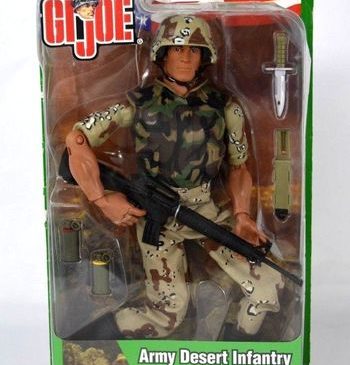
As I already suspected, Hasbro, the manufacturer of the above-pictured popular toy always took great care never to refer to it as a “doll”, but as an “action figure”, which was a term that they themselves invented! As per Wikipedia:
The conventional marketing wisdom of the early 1960s was that boys would not play with dolls and parents would not buy their sons dolls which have been traditionally a girl’s toy; thus the word “doll” was never used by Hasbro or anyone involved in the development or marketing of G.I. Joe.
The more general Wikipedia page on “action figures” states:
These figures are usually marketed toward boys and adult collectors. The term was coined by Hasbro in 1964 to market G.I. Joe to boys.
Though Wikipedia can be quite unreliable on some subjects, I see no reason to doubt them on this one. To me, it totally rings true that Hasbro (or somebody in their marketing department, to be precise) came up with the term “action figure” to avoid using the dreaded taboo word “doll”.
Boys do not play with dolls. It might look like that, but don’t believe your lying eyes. These are not dolls. They are action figures.
Just as boys do not play with dolls, America does not torture prisoners. This is not torture. It is enhanced interrogation.

So, the Illustrated 9/11 Commission Report is definitely not a comic book. As I recall, a comic book marketed at people who are too old to be reading comic books is usually called a graphic novel, but it’s not that either, because the word “novel” would be admitting that it is a fiction, no? So, this is called a graphic adaptation. The full title on amazon.com is The 9/11 Report: A Graphic Adaptation. I now realize that my copy is a British edition from Penguin Books that, for some reason, is just called the Illustrated 9/11 Commission Report.
Getting back to G.I. Joe, I am hardly surprised that the product line is now “diverse”. However, I would have guessed that, originally, you could get G.I. Joe in any color as long as that color was white. But actually, I now see that the G.I. Joe product line was first launched in 1964 and the first colored negro black African-American G.I. Joe dates back to 1965. Is it a coincidence that this is about when America’s involvement in the Vietnam war was ramping up? Maybe the Pentagon told Hasbro that black boys should also get the message that war could be lots of fun for them too.
However, I am pretty sure that the Osama Bin Laden action figure only comes in one color.
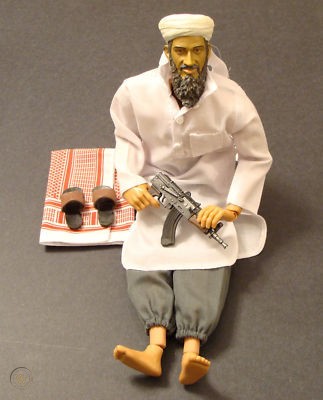
As for my rhetorical question of whether Bin Laden is a cartoon character, well…
Get with the program! The War on Terror is no cartoon! It’s an animated feature!“